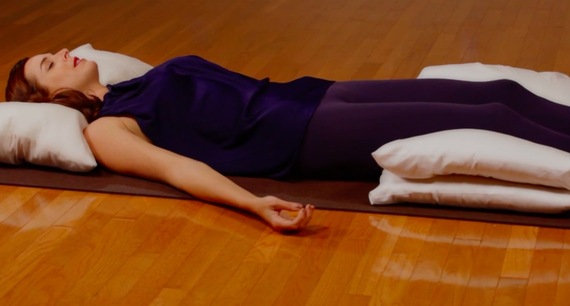The way we respond to stressful situations can affect our heart rate and blood pressure. A stress response can up regulate the sympathetic nervous system, which is also known as our fight or flight response. When the sympathetic nervous system is chronically up regulated, it increases cortisol and adrenaline in the blood stream. This in turn increases our heart rate and constricts our blood vessels, which increases our blood pressure.
Yoga has long been touted as a powerful tool to manage stress and induce a sense of peace and well-being. Certain yoga practices can down regulate the sympathetic response and up regulate the parasympathetic response or "the relaxation response." A study by scientists in India found that yoga helped to decrease sympathetic activity and oxidative stress that leads to high blood pressure. The authors concluded that yoga plays an important role in reducing the risk of mild to moderate hypertension.
The practices and techniques of yoga vary widely, so it can be unclear which yogic practices are the most helpful and useful in actually lowering blood pressure. Many of the studies don't define which techniques of yoga are being used. There are, however, a few studies that do show that three techniques stand out for helping to lower blood pressure.
Deep Relaxation
Enjoy this Ornish Practice Video, Lying Down on Back
Two studies suggest that the practice of systematic relaxation, or "shavasana" is extremely beneficial in lowering blood pressure. In one study, researchers found that blood pressure could be controlled with relaxation techniques in 65% of patients. The researchers did not use any drug intervention to achieve this response. They also reported that if patients stopped practicing, their blood pressure rose significantly to pre-shavasana levels.
Slow Conscious Breathing
Enjoy this Ornish Practice Video, Breathing to Relax and Renew
When I was working as a stress management specialist in Dr. Ornish's Lifestyle Heart Trial, our nurses became very excited about the effects of yoga on blood pressure. After learning and practicing some of the yogic breathing techniques for themselves, they wanted to do their own informal research.
When Ornish participants came in for their evening program with elevated blood pressures, the nurses would have them practice a stress management technique called 2 to 1 breathing where the exhale breath is extended twice as long as the inhale breath. They noticed that within just 5 minutes most participants' blood pressure would come down. This not only empowered the participants to care for themselves, but it inspired the nurses to be more helpful to the participants. Often the nurses would even stop and breathe with them for several minutes. It became a wonderful way for the nurses to connect with the participants in a loving and supportive way.
Now formal studies have found that simple slow breathing can help to lower blood pressure.
Meditation
Enjoy this One-Hour Meditation Practice
Meditation also has a powerful and notable impact on blood pressure. It differs from deep relaxation, where the body and mind become systematically relaxed. During meditation, we gather up the mind and focus on one object. This is because our mind rarely stays focused; it has an infinite number of directions it can travel through free association. When we focus our attention on one thing, it allows the mind to rest from its constant state of movement from one thought to the next. This restful state of mind supports a restful heart.
Researcher have found that a regular meditation practice can reduce systolic and diastolic blood pressure by 4.7 and 3.2, which are clinically meaningful changes.
All of these techniques continue to be used as part of the stress management protocols in the Ornish Reversal Program (Intensive Cardiac Rehabilitation). They contribute to the overall reduction of blood pressure in our participants. Using this holistic approach to balance blood pressure empowers you to hold your healing in your own hands. Lets all take a deep breath together and relax.
Which of these stress management techniques have worked for you?
Have a questions regarding transforming your way of eating and living, 'Ask Dr. Ornish'!
